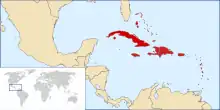
The Antilles[1] is an archipelago bordered by the Caribbean Sea to the south and west, the Gulf of Mexico to the northwest, and the Atlantic Ocean to the north and east.
The Antillean islands are divided into two smaller groupings: the Greater Antilles and the Lesser Antilles. The Greater Antilles includes the Cayman Islands and larger islands of Cuba, Hispaniola (subdivided into the nations of the Dominican Republic and Haiti) and Navassa Island, Jamaica, and Puerto Rico. The Lesser Antilles contains the northerly Leeward Islands and the southeasterly Windward Islands as well as the Leeward Antilles just north of Venezuela. The Lucayan Archipelago (consisting of The Bahamas and the Turks and Caicos Islands), though a part of the West Indies, is generally not included among the Antillean islands.[2]
Geographically, the Antillean islands are generally considered a subregion of North America. Culturally speaking, Cuba, the Dominican Republic, and Puerto Rico – and sometimes the whole of the Antilles – are included in Latin America, although some sources use the phrase "Latin America and the Caribbean" instead (see Latin America, "In Contemporary Usage").[3] In terms of geology, the Greater Antilles are made up of continental rock, as distinct from the Lesser Antilles, which are mostly young volcanic or coral islands.
Background

The word Antilles originated in the period before the European colonization of the Americas, Antilia being one of those mysterious lands which figured on the medieval charts, sometimes as an archipelago, sometimes as continuous land of greater or lesser extent, its location fluctuating in mid-ocean between the Canary Islands and India.[4]
After the 1492 arrival of Christopher Columbus's expedition in what was later called the West Indies, the European powers realized that the dispersed lands constituted an extensive archipelago in the Caribbean Sea and the Gulf of Mexico. The Antilles were called multiple names before their current name became the norm. Early Spanish visitors called them the Windward Islands (today having a narrower definition). They were also called the Forward Islands by 18th-century British.[5] Thereafter, the term Antilles was commonly assigned to the formation, and "Sea of the Antilles" became a common alternative name for the Caribbean Sea in various European languages.
Countries and territories

Lucayan Archipelago
Greater Antilles
- Cayman Islands (United Kingdom)
- Cuba
- Hispaniola
- Jamaica
- Puerto Rico (United States)
Lesser Antilles
Leeward Antilles
- Aruba (Kingdom of the Netherlands)
- Bonaire (Netherlands)
- Curaçao (Kingdom of the Netherlands)
- Federal Dependencies of Venezuela
- Nueva Esparta State (Venezuela)
Leeward Islands
- Anguilla (United Kingdom)
- Antigua and Barbuda
- British Virgin Islands (United Kingdom)
- Guadeloupe (France)
- La Désirade
 Fort Napoléon, Les Saintes, Guadeloupe
Fort Napoléon, Les Saintes, Guadeloupe - Les Saintes
- Marie-Galante
- Montserrat (United Kingdom)
- Saba (Netherlands)
- Saint Barthélemy (France)
- Saint Martin
- Saint Kitts and Nevis
- Sint Eustatius (Netherlands)
- Spanish Virgin Islands (Puerto Rico)
- United States Virgin Islands (United States)
Windward Islands
Other islands
See also
References
- ↑ (/ænˈtɪliːz/; Antillean Creole: Antiy; Spanish: Antillas; French: Antilles; Dutch: Antillen; Haitian Creole: Antiy; Papiamento: Antiyas; Jamaican Patois: Antiliiz)
- ↑ Some sources, such as Encarta in Spanish, include the Bahamas in the Antilles. Archived 2009-10-04 at the Wayback Machine (in Spanish). Archived 2009-10-31.
- ↑ "85.04.04: The Geophysics and Cultural Aspects of the Greater Antilles". teachersinstitute.yale.edu. Archived from the original on 2018-03-23. Retrieved 2017-11-21.
- ↑ One or more of the preceding sentences incorporates text from a publication now in the public domain: Chisholm, Hugh, ed. (1911). "Antilles". Encyclopædia Britannica. Vol. 2 (11th ed.). Cambridge University Press. p. 126.
- ↑ Kitchin, Thomas (1778). The Present State of the West-Indies: Containing an Accurate Description of What Parts Are Possessed by the Several Powers in Europe. London: R. Baldwin. p. 5. Archived from the original on 2015-02-21. Retrieved 2013-08-30.
